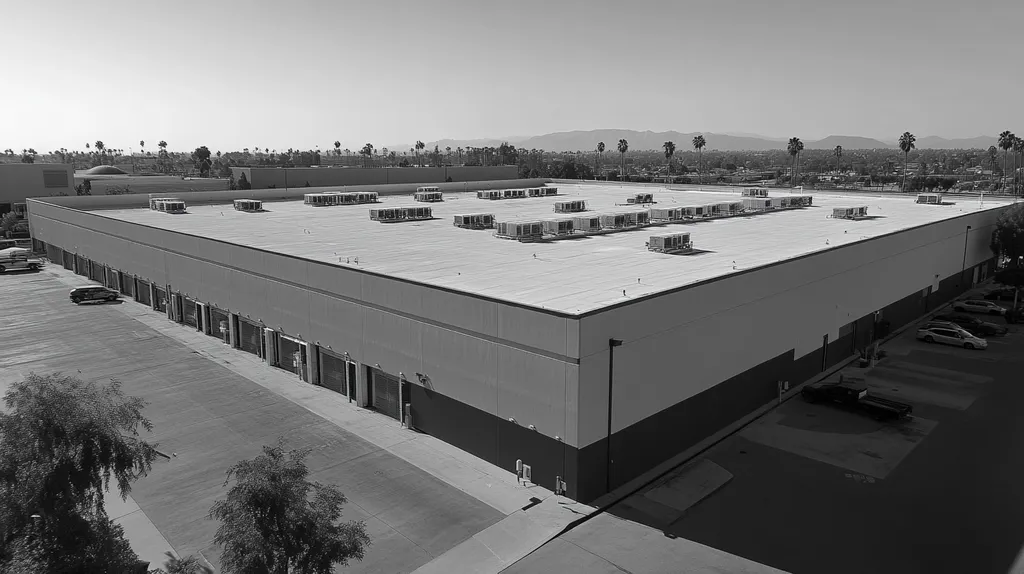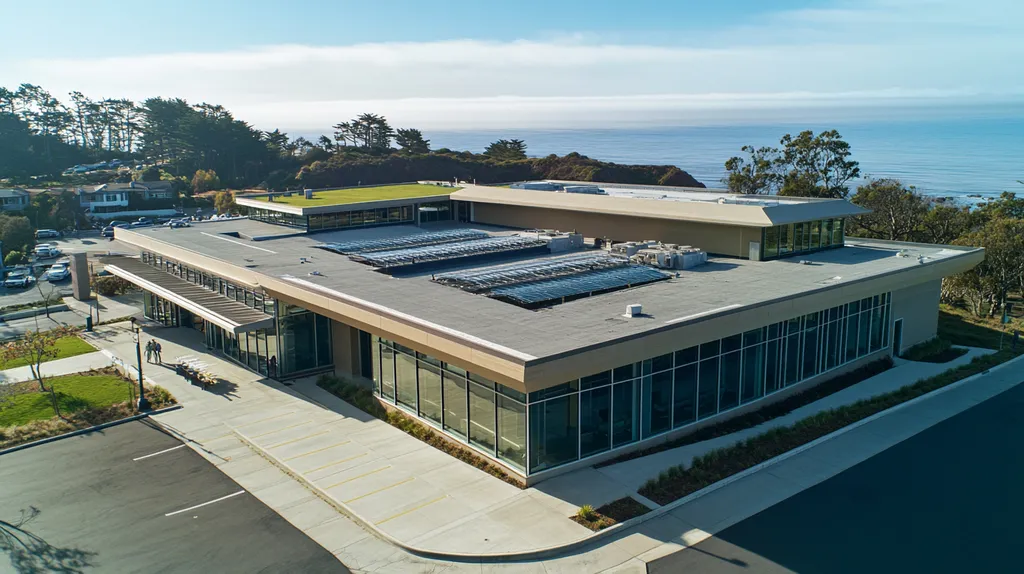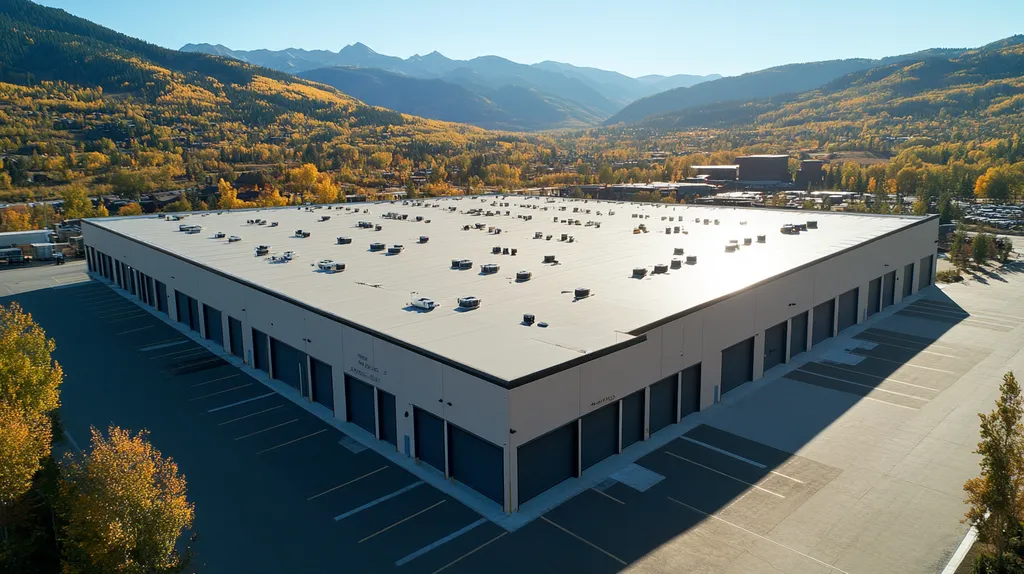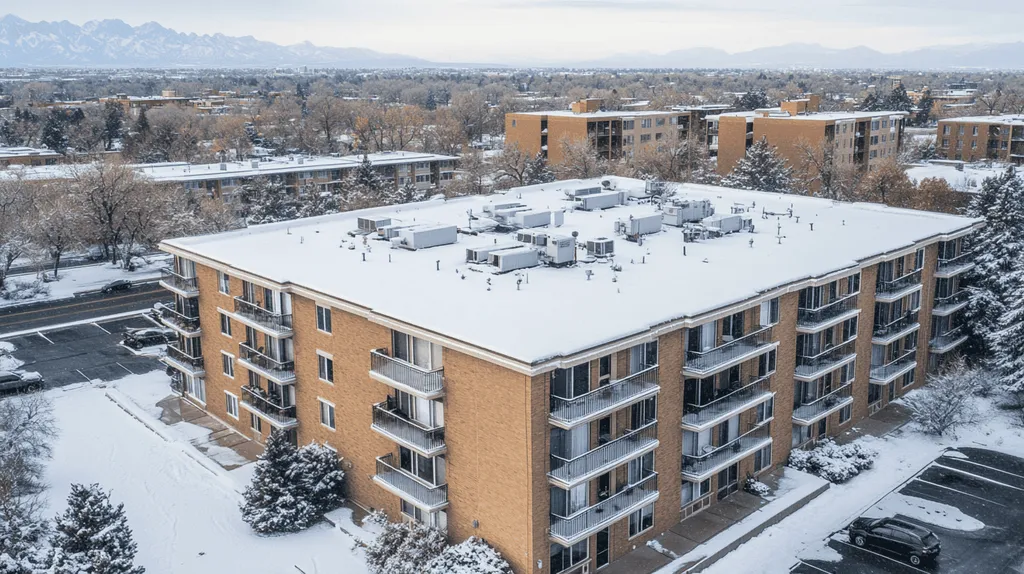Welcome to today’s Battle Royale featuring two roofing heavyweights: “TPO Roofing” in the east corner versus “Metal Panel Roofing” in the west!
Tonight’s showdown pits these contenders against each other across six punishing rounds designed to test every aspect of their performance for food processing industrial roofs.
At stake? Millions in potential costs, decades of building protection, and the critical performance demands of modern commercial and industrial facilities.
Our professional judging panel will evaluate each round on technical merit, real-world performance, and value delivery. After all six rounds, we’ll declare our ultimate champion.
Ladies and gentlemen, facility managers and building owners… it’s time to rumble!
ROUND 1: INITIAL COSTS & INSTALLATION
In food processing facilities, roofing decisions carry immense weight due to strict regulatory requirements and contamination risks. A single roofing failure can result in millions of dollars in damaged product, regulatory violations, and production shutdowns. The initial investment and installation process must be carefully evaluated to ensure both immediate feasibility and long-term success.
Material Expenses
Material selection directly impacts both initial costs and long-term performance in food processing environments. TPO roofing membrane typically costs $3.50 to $7.00 per square foot installed, making it an attractive option for facilities working within strict budgets.
Metal panel systems command premium pricing, usually ranging from $7.00 to $14.00 per square foot installed. While this higher cost reflects superior durability and longevity, it can strain initial project budgets.
Single-ply TPO systems offer excellent value while maintaining required performance standards for food processing facilities. Their efficient installation process and proven vapor barrier properties make them particularly suitable for refrigerated environments. (source: Stellar Food for Thought)
In this category, TPO roofing claims an “ADVANTAGE” due to its lower initial cost while still meeting industry requirements.
Installation Complexity
Installation complexity affects not only initial costs but also facility operations and food safety protocols. TPO roofing installation typically requires fewer specialized tools and can be completed with smaller crews, reducing coordination complexity.
Metal panel installation demands precise measurements, specialized equipment, and larger crews. This increased complexity extends project timelines and requires more extensive preparation and staging areas.
For food processing facilities, simpler installation processes mean fewer opportunities for contamination and shorter production interruptions. TPO’s straightforward installation process minimizes these risks.
TPO roofing earns another “ADVANTAGE” for its simpler, more efficient installation process.
Project Timeline
Project duration directly impacts production schedules and facility operations. TPO roofing installations typically complete in half the time of metal panel systems, with most projects finishing within 5-7 working days for a standard facility.
Metal panel installations often require 10-14 working days for similar square footage. This extended timeline increases exposure to weather risks and production disruptions.
Food processing facilities must carefully consider how installation timelines affect their production schedules and regulatory compliance. Shorter installation windows reduce the risk of contamination and regulatory issues.
TPO roofing secures another “ADVANTAGE” for its shorter project timeline and reduced operational impact.
ROUND 1 WINNER: TPO Roofing
ROUND 2: DURABILITY & LIFESPAN
In food processing facilities, roof failure isn’t just an inconvenience – it’s a potential catastrophe that can halt production, compromise food safety, and trigger costly regulatory violations. A single leak can contaminate thousands of dollars worth of product and shut down processing lines for days or weeks.
Understanding how different roofing systems perform over time is crucial for facility managers who need to balance immediate costs against long-term reliability. Let’s examine how TPO and metal panel roofing compare in terms of durability and lifespan.
Longevity
TPO roofing typically lasts 15-20 years when properly installed and maintained. However, in food processing environments, its lifespan can be reduced by exposure to oils, fats, and chemical cleaners that are common in these facilities.
Metal panel roofing systems offer significantly longer lifespans, often exceeding 40 years with proper maintenance. Their robust construction provides superior resistance to chemicals, oils, and cleaning agents commonly found in food processing environments.
The dramatic difference in expected service life gives metal panel roofing a clear ADVANTAGE in this category.
Impact and Puncture Resistance
TPO membranes can be vulnerable to punctures from falling objects, maintenance foot traffic, and equipment installation. While thicker TPO membranes offer improved puncture resistance, they remain more susceptible to damage than metal alternatives.
Metal panel systems excel at resisting impacts from hail, fallen branches, and maintenance activities. Their rigid structure disperses impact forces across a wider area, preventing localized damage that could compromise the roof’s integrity.
Given its superior resistance to physical damage, metal panel roofing earns another ADVANTAGE in this category.
Maintenance Requirements
TPO roofing requires regular inspections and maintenance to ensure seam integrity and address any developing issues. Repairs often involve patching or re-welding seams, which can temporarily disrupt facility operations.
Metal panel systems typically need less frequent maintenance, mainly requiring periodic inspection of fasteners and sealants. Their durable construction means fewer repairs and less potential for disruption to food processing operations.
Due to lower maintenance demands and reduced operational disruption, metal panel roofing claims another ADVANTAGE.
ROUND 2 WINNER: Metal Panel Roofing
ROUND 3: PERFORMANCE FACTORS
In food processing facilities, roof performance directly impacts food safety, regulatory compliance, and operational efficiency. Even minor performance issues can cascade into major problems, from temperature control failures to contamination risks. The roof’s role as a critical component of the building envelope demands careful evaluation of how different systems perform under the unique demands of food processing environments.
Durability and Weather Resistance
Food processing facilities require roofing systems that can withstand extreme temperature fluctuations, chemical exposure, and constant mechanical stress. TPO roofing offers excellent flexibility and UV resistance, helping it maintain structural integrity despite thermal cycling.
Metal panel systems provide superior resistance to severe weather events and physical impacts. Their rigid construction prevents warping under heavy snow loads and offers better protection against wind-driven rain.
While both materials demonstrate strong durability characteristics, metal panel roofing’s superior resistance to extreme conditions and minimal degradation over time earns it an ADVANTAGE in this category.
Thermal Performance
The roof is the area of the building envelope with the greatest potential to affect long-term performance of the facility. TPO roofing’s highly reflective surface helps maintain consistent interior temperatures, reducing the load on cooling systems and supporting precise climate control for food processing operations. (source: Refrigerated & Frozen Food)
Metal panel roofing systems typically require additional insulation layers to achieve comparable thermal performance. While effective when properly installed, they generally don’t match TPO’s natural reflective properties.
Given its superior thermal performance and energy efficiency benefits, TPO roofing claims the ADVANTAGE in this category.
Chemical Resistance
Food processing environments expose roofing systems to harsh cleaning chemicals, sanitizing agents, and food-grade materials that can degrade traditional roofing materials. TPO roofing offers good initial chemical resistance but may show signs of degradation with prolonged exposure.
Metal panel roofing excels in chemical resistance due to its non-porous nature and protective coatings. It maintains its structural integrity even when regularly exposed to aggressive cleaning agents and food processing byproducts.
Metal panel roofing’s superior long-term chemical resistance and minimal degradation earn it a clear ADVANTAGE in this category.
ROUND 3 WINNER: METAL PANEL ROOFING
ROUND 4: MAINTENANCE REQUIREMENTS
For food processing facilities, roof maintenance isn’t just about preventing leaks – it’s about protecting millions of dollars in inventory and maintaining strict regulatory compliance. A single maintenance oversight can cascade into failed inspections, contaminated products, or complete production shutdowns that cost facilities thousands per hour in lost revenue.
Inspection Frequency and Complexity
TPO roofing systems require quarterly inspections focusing on seam integrity, membrane punctures, and drainage systems. These inspections can typically be completed in a single day with minimal disruption to facility operations.
Metal panel systems demand more complex inspections that examine fasteners, panel joints, and potential corrosion points. These thorough evaluations often require specialized equipment and can take 2-3 days to complete properly.
The simpler inspection requirements and reduced facility disruption give TPO roofing the ADVANTAGE in this category.
Repair Procedures
TPO repairs usually involve simple patching or heat-welding techniques that can be completed quickly by trained technicians. Most repairs can be performed without shutting down production areas, maintaining facility efficiency.
Metal panel repairs often require panel replacement or extensive sealant work, creating longer repair windows and greater potential for production disruption. The noise and equipment requirements can interfere with normal facility operations.
Given its faster, less disruptive repair procedures, TPO roofing claims another ADVANTAGE.
Long-term Maintenance Costs
The roof represents the building component with the greatest potential to impact facility performance and maintenance expenses. Regular maintenance is essential for preventing condensation issues that can compromise food safety and trigger costly shutdowns. (source: Refrigerated & Frozen Food)
TPO systems typically require annual maintenance budgets of $0.10-$0.15 per square foot. These costs remain relatively stable throughout the roof’s lifespan, making long-term expenses predictable.
Metal panel systems often start with lower maintenance costs but can spike significantly if corrosion or panel replacement becomes necessary. This unpredictability makes budgeting more challenging.
TPO roofing’s predictable maintenance costs earn it another ADVANTAGE in this category.
ROUND 4 WINNER: TPO Roofing
ROUND 5: SUSTAINABILITY CREDENTIALS
In food processing facilities, sustainability isn’t just about environmental impact – it’s about operational efficiency, regulatory compliance, and brand reputation. A poorly chosen roofing system can lead to excessive energy consumption, increased waste, and higher operational costs that impact both the environment and the bottom line.
Modern food processing facilities must balance strict environmental regulations with increasing pressure to reduce their carbon footprint. The right roofing choice plays a crucial role in meeting these competing demands.
Energy Efficiency
Energy consumption represents one of the largest operational expenses for food processing facilities. TPO roofing’s highly reflective surface significantly reduces cooling loads, with many facilities reporting 15-30% reductions in HVAC energy usage.
The roof is the area of the building envelope with the greatest potential to affect long-term performance of the facility. TPO’s superior insulation properties and reflective characteristics help maintain consistent temperatures while minimizing energy waste. (source: Refrigerated & Frozen Food)
Metal panel systems typically absorb more heat and require additional insulation layers to achieve comparable energy performance. Even with specialized coatings, they rarely match TPO’s natural energy-saving properties.
TPO roofing claims a clear ADVANTAGE in energy efficiency.
Material Recyclability
Food processing facilities generate significant waste streams, making recyclable building materials increasingly important. TPO membranes can be fully recycled at end-of-life, with many manufacturers offering take-back programs.
Metal panels boast excellent recyclability, with most containing 25-95% recycled content. These panels can be repeatedly recycled without degradation, making them highly sustainable from a materials perspective.
Both systems demonstrate strong environmental credentials in this category, resulting in a TIE.
Environmental Impact
Manufacturing TPO membranes requires less energy than metal panel production. The lighter weight of TPO also reduces transportation emissions and installation equipment requirements.
Metal panel production has a larger carbon footprint initially, but this impact is partially offset by the material’s longer lifespan and complete recyclability. However, the energy-intensive manufacturing process remains a significant environmental consideration.
Given its lower production impact and reduced operational carbon footprint, TPO roofing earns another ADVANTAGE.
ROUND 5 WINNER: TPO Roofing
ROUND 6: SPECIALIZED APPLICATIONS
In food processing facilities, specialized roofing requirements can make or break operations worth millions of dollars. Temperature control failures, condensation issues, or contamination risks from improper roofing choices can trigger FDA violations and force complete facility shutdowns. Understanding how different roofing systems perform under these demanding conditions is crucial for maintaining both food safety and operational continuity.
Temperature Control Requirements
Food processing facilities demand precise temperature control to maintain product quality and safety. A well-designed roof assembly must include effective air and vapor barriers to prevent condensation and maintain stable internal temperatures. (source: Refrigerated & Frozen Food)
TPO roofing systems excel in temperature control applications, offering superior insulation properties and reflective characteristics. Their seamless installation creates an effective vapor barrier that prevents moisture infiltration and helps maintain consistent temperatures.
Metal panel systems often require additional vapor barrier layers and specialized installation techniques to achieve comparable temperature control. Their thermal conductivity can make maintaining stable temperatures more challenging and energy-intensive.
TPO roofing claims the ADVANTAGE for superior temperature control capabilities.
Chemical and Contamination Resistance
Food processing environments expose roofing materials to harsh cleaning chemicals, sanitizing agents, and food-grade materials. Roofing systems must withstand regular exposure to these substances without degradation or contamination risks.
TPO membranes offer good initial chemical resistance but may show signs of degradation with prolonged exposure to harsh cleaning agents. Their smooth surface helps prevent bacterial growth but can become compromised if chemical exposure persists.
Metal panel systems demonstrate exceptional resistance to chemical exposure and cleaning processes. Their non-porous nature and protective coatings maintain integrity even under aggressive cleaning protocols.
Metal panel roofing earns the ADVANTAGE for superior chemical resistance.
Ventilation Integration
Proper ventilation is critical in food processing facilities to maintain air quality and prevent contamination. Roofing systems must accommodate complex ventilation requirements without compromising structural integrity.
TPO roofing allows for simple integration of ventilation systems, with flexible flashing options that maintain watertight seals. The membrane’s adaptability makes it easier to install and maintain ventilation components.
Metal panel systems require more complex modifications for ventilation integration. While durable, their rigid structure makes accommodating ventilation systems more challenging and potentially more costly.
TPO roofing claims another ADVANTAGE for superior ventilation integration capabilities.
ROUND 6 WINNER: TPO Roofing
AND THE WINNER IS…
After six grueling rounds of technical evaluation, the judges’ scorecards are in! With four rounds to two, TPO Roofing claims victory in this heavyweight clash of food processing facility contenders!
TPO dominated with its superior cost-effectiveness, streamlined installation process, straightforward maintenance requirements, and impressive sustainability credentials. Its ability to deliver precise temperature control while accommodating complex ventilation systems proved decisive in specialized food processing applications.
But don’t count Metal Panel Roofing out! This durable challenger showed its worth in Round 2 and Round 3, demonstrating superior longevity and outstanding chemical resistance. For facilities prioritizing maximum lifespan and minimal long-term maintenance, metal panels remain a formidable choice.
Remember, folks – every facility faces unique challenges. Local climate conditions, regulatory requirements, and specific operational demands can all impact roofing performance. While tonight’s victory goes to TPO, building owners should always consult qualified roofing professionals who can evaluate their specific situation and requirements before making their final selection.
In the high-stakes arena of food processing facility roofing, there’s no substitute for matching your specific operational demands with the right roofing system’s strengths. Choose wisely – because in this game, the real championship belt goes to those who protect their operations with properly specified solutions!
FREQUENTLY ASKED QUESTIONS
Q. What are the initial costs for a commercial roof?
A. Initial costs for roofing vary significantly. TPO roofing typically ranges from $3.50 to $7.00 per square foot, making it budget-friendly. In contrast, metal panels can cost between $7.00 and $14.00 per square foot, reflecting their higher durability yet straining project budgets.
Q. How long do commercial roofs last?
A. TPO roofs generally last around 15-20 years under proper maintenance but may face challenges in food processing environments. Metal panels, however, can exceed 40 years, providing significantly longer lifespans and better durability for harsh conditions.
Q. Which roofing type performs better under extreme conditions?
A. Metal panel roofing outperforms TPO in extreme conditions due to its robust resistance to severe weather events and physical impacts. Its rigid structure helps prevent warping or damage, making it ideal for the demanding environment of food processing facilities.
Q. What are the maintenance requirements for industrial roofs?
A. TPO roofing requires simpler and quicker inspections every quarter, focusing on seams and drainage. In contrast, metal panels involve more complicated inspections and can take longer to properly assess, leading to increased disruption during the maintenance process.
Q. How do these roofs affect energy efficiency?
A. TPO roofs contribute significantly to energy efficiency with their reflective surfaces, reducing cooling loads and energy usage by up to 30%. Metal panels, however, tend to absorb more heat and need extra insulation layers, making them less efficient than TPO systems in maintaining temperature stability.
Q. How do TPO and metal panels handle chemical exposure?
A. Metal panel systems offer superior chemical resistance since their non-porous nature withstands harsh cleaning agents better than TPO. Although TPO can initially resist chemicals, prolonged exposure can degrade its integrity, especially in food processing environments.
Q. What about recycling and sustainability for commercial roofs?
A. TPO roofs can be fully recycled at the end of their life, with many manufacturers offering take-back programs. On the other hand, metal panels are also highly recyclable and often contain significant recycled content, making both options environmentally friendly choices.











